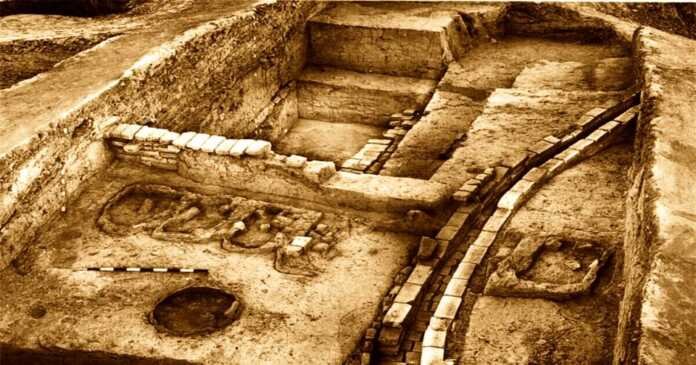Archaeological Studies In Rajasthan need immediate attention of national and international Archaeologists. Intruders and poachers may destroy the Archaeological sites by encroaching the land. Government agencies are unable to protect these sites.
Luckily, Rajasthan is a rich land for archaeological studies. It has drawn the attention of eminent Archaeologists like Ratan Chandra Agarwal, Birbal Sahani, V. N. Misra, B. B. Lal, H. D. Sankalia and other reputed scholars of Archaeology.
Aarchaeologists have done a commendable work in this sphere. With their findings, it has now become almost an established fact that besides Baluchistan, Sindh and the Punjab, Rajasthan also has been the cradle of the earliest civilization in India.
The Department of Archaeology in the State, under its directors late S. P. Srivastava and R. C. Agarwal, assisted by their colleagues, undoubtedly have done a lot to supplement the work of the Archaeological Survey of India, but still there is much to be done in the region. Further archaeological exploration and excavation in Rajasthan is an urgent necessity.
It would be laudable if the Universities of the State also play their role in the venture There is a complete stagnation, in fact no work has been done in the field of historical archaeology in Rajasthan. The interaction between historical archaeology and ancient or early medieval history of the region has to be explored. In order to ascertain the facts fully, one should make a combined use of excavation reports, numismatic studies, foreign accounts and native literature.
There are many ancient temples in Rajasthan. Recent studies of these temples by various scholars have revealed only the measurements of structure, classification of art style, indexing and dicipherment of inscriptions, a little digression on social data and nothing more.
We need a detailed and rigorous analysis of the socio-political and economic significance of the temple as an institution. The various aspects of this feudal-social formation such as temple property, superiority of the priestly class, caste rigidity, sex-dominated sculptural art forms etc. should be studied.
We may also enquire into its socio-economic functions of the temple. Prof. K. A. N. Shastri has briefly summarised the functions of the temples – “As land owner, employer and consumer of goods, and services; as bank, school and museum, in short, as a nucleus which gathered round itself all that was the best in the art of civilized existence and regulated them with the humaneness born of the spirit of dharma, the medieval temple has few parallels in the annals of mankind.”
Prof. Shastri has talked of the temples which existed in the south., but on their anology, we may legitimately surmise that the temples in Rajasthan, with slight variations here and there, had similar functions to perform.
The temple lent money to individuals or local bodies in times of scarcity or distress and it served as the peoples’s bank. It is on record that even in the second half of the 19th century, in the erstwhile state of Sirohi, the temples advanced money to the State or the Jagirdar, as the case might be, for constructing wells or bunds.
There is plenty of scope for archaeological studies in relation to the temple-oriented settlements (houses of priests, artisans, peasants, bazaars, farms, and their social and economic implications etc.), in different parts of Rajasthan at different times. Then the findings could be corelated to those from other sources. Horizontal studies in selected areas of the region will help us to identify the settlement patterns and bring out the ecology and sociology of such settlements in early medieval Rajasthan.
One such study can be undertaken at Kiradu, an ancient site, situated about 26 Kms. north-west of Barmer. This Project should be undertaken soon, as the district authorities of Barmer are contemplating an ambitious project at an estimated cost of rupees ten lakhs for placing this ancient town on the tourist map of Rajasthan.
The extensive ruins of the temple, the fort and other buildings spread over a wide area of more than one square kilometer in circumference suggest that Kiradu was once a flourishing and prosperous town and also a great centre of art, besides being possibly a centre of trade and commerce.
We have a fairly good account of this historic town of Kiradu on the basis of written documents; but on a close scrutiny, we may notice that there are many missing links to be filled in and many twists to be straightened by an archaeological study of the region.
The archaeological evidence will not only challenge the descriptions adduced by the chroniclers, but possibly it may also compel us to abandon or revise various pre-conceived notions of history propounded by the arm-chair historians; R. N. Mehta, who conducted excavation at Champaner, the Capital town of Mahamud Begra, the Sultan of Gujarat, has questioned Abul Fazal’s statement regarding the burning of Champaner by Bahadur Shah who was defeated by Humayun.
R. N. Mehta has tried to show the potentiality of archaeology, as a tool for studying the medieval period. There are many early medieval sites in Rajasthan like Ludarva in the Jaisalmer district, Mandor in the Jodhpur district, Khed in the Barmer district and many more such sites spreading all over the state.
They await a thorough and persistent archaeological effort for removing the haze in the social, cultural and economic set-up of the medieval Rajasthan. Such efforts will certainly open up new horizons of knowledge. Martin Biddle, who worked as the director of excavations at Winchester and handled the excavation works of many British towns, observes’ ‘It is only through a combination of these two complimentary sources documentery and archaeology – that a balanced account of urban history can be written.”
Incidentally, I may refer here to a survey conducted by a voluntary organisation in the Hadoti area of Rajasthan, comprising Kota, Bundi, Sawai Madhopur and Jhalawar districts. It revealed that thousands of manuscripts, containing great historical data, and a large number of idols and wall paintings of antiquarian significance have been lying neglected in temples and other places.
Some of the manuscripts and idols have already been stolen or smuggled away, as there was no check or supervision on them. The pilferage is still going on. The temples at Badoli, the Ranthambhor fort and Devra have been a prey to such smugglings.
The great temple of Bhand Devra, which was built by cutting one single rock in the ancient times, is decaying. It appears to me that the Antiquities and Art Treasure Act of 1972 has not been effectively implemented in the area.
The government and the concerned departments are earnestly urged upon to encourage the Archaeological Studies In Rajasthan.




